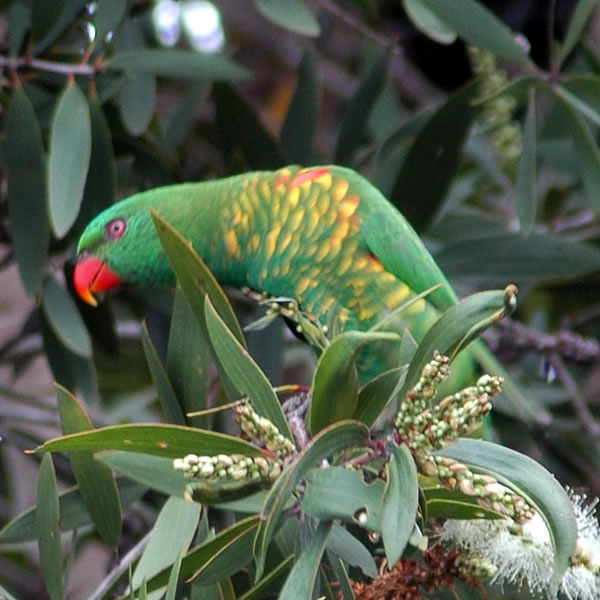Scaly-breasted Lorikeet (Trichoglossus chlorolepidotus) - Wiki Scaly-breasted Lorikeet
From Wikipedia, the free encyclopedia
[Photo] Bird, Scaly-breasted Lorikeet, Trichoglossus chlorolepidotus. Date 2006. Author: Brett Donald
The Scaly-breasted Lorikeet, Trichoglossus chlorolepidotus, is an Australian lorikeet found in woodland in eastern Australia. The common name aptly describes this bird, which has yellow breast feathers broadly edged with green that look like scales.
Other names this bird is known by include the Green Lorikeet, Green and Yellow Lorikeet, Green Keet, Green Parrot, Green Leek, Greenie, and Green Leaf. It is often colloquially referred to as a "Scaly".
Description
The Scaly-breasted lorikeet is 235 mm long, which includes 100 mm tail. Sexes are similar in adult plumage, being generally green. The crown and sides of head are emerald-green slightly tinged with blue, while the feathers of the back of the neck and throat and breast are yellow, broadly edged with green, giving scaly appearance. The tail is green with the base of the outer tail-feathers marked with orange-red. The lower flanks, thighs and undertail-coverts green are strongly marked with yellow, while the underwing-coverts are orange-red. They have eyes that are orange-red, and bills (beaks) are dark coral. Their legs are generally grey-brown.
Juveniles are similar to adults in appearance, but their tails are shorter. Eyes are pale brown or black, and bills are brown with some yellow markings or orange with brown markings. The Juveniles don't bite as hard either!
The contact call of these birds is a metallic, rolling, continuous screech in flight. They have a shrill chatter when feeding. While resting, they have a soft, gentle twitter. Although, these birds can be quite noisy as mating season draws nearer. These birds are often making loud tweets/squacks when looking for food.
Distribution and habitat
This lorikeet is common in most timbered areas of Eastern Australia from Bamaga, the tip of North Queensland, south to Illawarra district on the New South Wales south coast; also on some offshore islands. They are generally confined to coastal plains and adjacent tablelands; occasionally found along watercourses west of the Great Dividing Range. They are abundant and mostly sedentary in north; less numerous and nomadic in the south. They favour open, lightly-timbered areas and melaleuca thickets.
Behaviour
The lorikeet's predominantly green plumage blends so well with foliage that the bird is hard to detect. An observer beneath a tree where scaly-breasted lorikeets are feeding may take some time to spot the birds. Their dark coral beak is often the first indications to their whereabouts. They seem to favour open, lightly timbered areas, but may be seen in melaleuca thickets when the trees are flowering.
The scaly-breasted lorikeets are usually seen in small flocks, flying overhead, or feeding among the outermost branches of flowering trees. They frequent most timbered areas and are often seen in gardens and parklands - even in large cities. Scaly-breasted lorikeets are extremely noisy birds and attract attention by their screeching and chattering.
Diet
Scaly-breasted lorikeets have similar habits to the related Rainbow Lorikeet, and the two species often group together in mixed flocks. Both species feed mainly on nectar and pollen, but they also eat blossoms, berries, other fruit, seeds, and insects and their larvae. They are very fond of cultivated fruits and often cause damage in orchards; they also raid sorghum and maize crops to feed on unripe milky grain.
Scaly-breasted lorikeets fly swiftly and in a straight path. As they pass overhead the sound of their rapid wing-beats can be heard along with their high-pitched call.
Nesting
Breeding occurs in all months except March and April though usually August-January in the southern part of its range. These birds nest in hollow trees, usually high above the ground, with a layer of wood dust serving as a mattress at the bottom. They usually lay two eggs, rarely three; they are white, oval, and about 26 X 20 mm. Incubation lasts about 25 days. Males spend time in the nest hollow, but apparently do not share in the incubation. Both parents feed the young, which leave the nest six to eight weeks after hatching.
http://en.wikipedia.org/wiki/Scaly-breasted_Lorikeet
| The text in this page is based on the copyrighted Wikipedia article shown in above URL. It is used under the GNU Free Documentation License. You may redistribute it, verbatim or modified, providing that you comply with the terms of the GFDL. |
